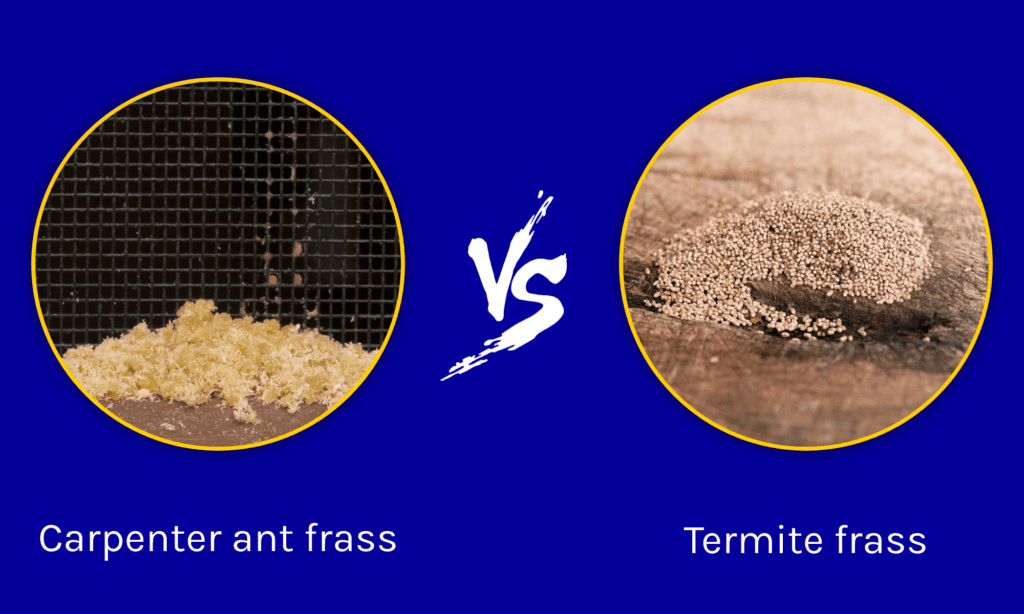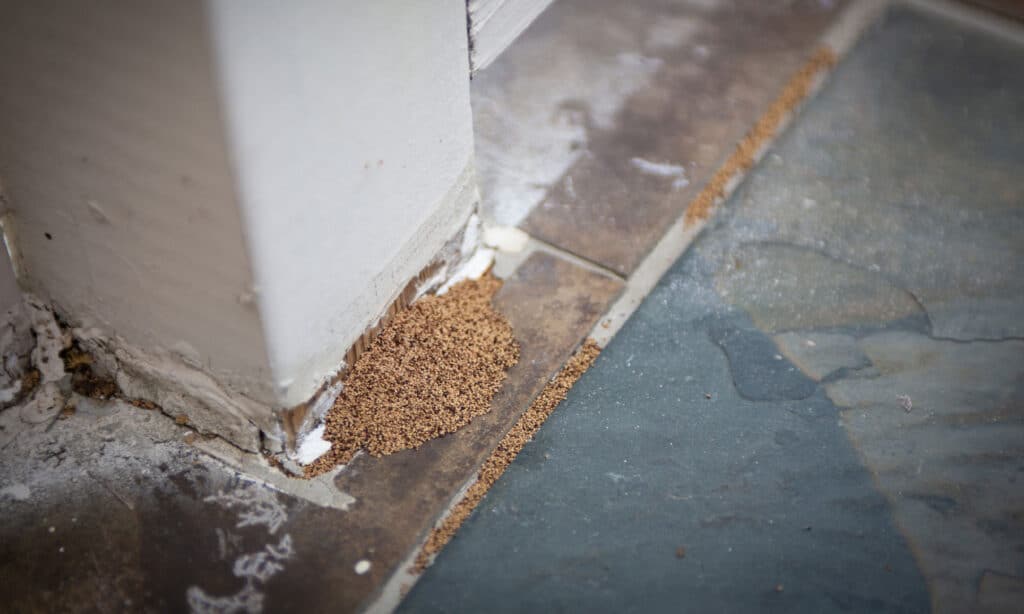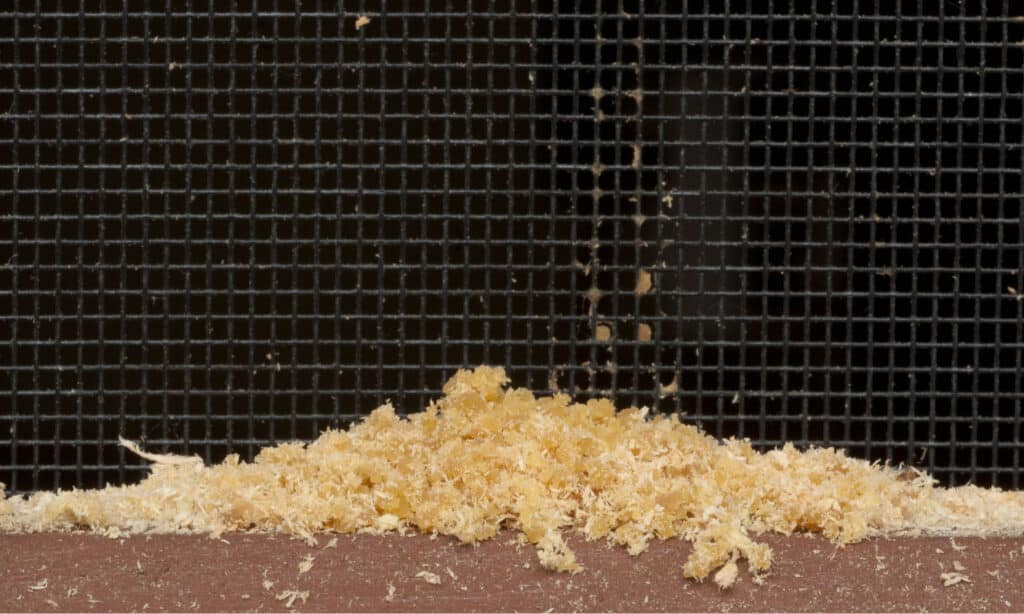Nobody loves to find out that they suffer from a carpenter ant infestation or a termite infestation. Unfortunately, these two insects have a reputation for destruction. They can tear your house apart if you give them just enough chance. To handle the infestation, you will need to identify which of them you are dealing with. While it’s rare to find them in the open most times, you would see their frass littered around the house. However, their frasses look alike, and it could be difficult to ascertain which of these little bulldozers you are dealing with just by looking at their frass. This article points out the differences between carpenter and frass and termite frass.
Comparing Carpenter Ant Frass and Termite Frass

| Carpenter Ant Frass | Termite Frass | |
|---|---|---|
| Size | Larger and inconsistent compared to termite frass | Smaller than carpenter ant frass and more refined in size |
| Colour | Like light-colored sawdust | Varying colors of tan and brown. |
| Shape | Like wood shavings | Oval-shaped pellets with elongated edges and six flat surfaces. |
| Frass placement | Found around the opening of nests | Found around the nest and underneath nests or infested wood. |
The Key Differences Between Carpenter Ant Frass vs. Termite Frass
The key differences between the carpenter ant and the termite frass include their size, weight, components, color, shape, and placement. Looking closely at these parameters would help one make the difference between the frass of these two insects.
Carpenter Ant Frass vs. Termite Frass: Components

Termite frass is a composition of wood mixed with termite droppings.
©iStock.com/lisatop
You can make out the differences between the frasses of the carpenter ant and the termite by checking their components. The frass of each one usually contains different things.
The carpenter ant frass contains a lot of wood compared to the termite, and this is because carpenter ants, as opposed to termites, do not eat the wood that they tunnel through. They make their way through the wood by burrowing tunnels. Asides from wood debris, the frass of carpenter ants would also contain body parts of dead insects, fecal matter(ant droppings), soil, and gravel.
On the other hand, termite frass doesn’t carry most of the components found in carpenter ant frass. It is just a composition of wood mixed with termite droppings; courtesy of their great appetite for wood.
Carpenter Ant Frass vs. Termite Frass: Size

The carpenter ant frass is bigger and less compact than the frass of a termite.
©Nancy Bauer/Shutterstock.com
One look at the frasses of the carpenter ant and the termite, and you might think they are all the same. But there is a difference in their size. The carpenter ant frass looks bigger and less compact when compared to that of the termite. The termite frass is smaller and seems better refined than the carpenter ant frass. This is because it is purely a product of a biological process as opposed to that of the carpenter ant, which is mostly a collection of different components from their burrowing activities. As a result, the frass of carpenter ants does not have a stable size, while the termite does.
Carpenter Ant Frass vs. Termite Frass: Color
The frasses of these two different insects also vary in color, and this is due to a few factors, including the kind of wood they consume and the refining process of the frass. The frass of the carpenter ant is usually like light-colored sawdust, while that of the termite comes mostly in varying colors of tan and brown. The color variation is because they consume different types of wood, so their frass mostly takes on the color of the wood consumed. So if, for example, they have been eating light-colored wood like the pine, their frass will be light colored. In the same vein, they would produce darker-looking frass if they had been consuming wood like the oak.
Carpenter Ant Frass vs. Termite Frass: Shape
While it may seem like both carpenter ant frass and termite frass are of the same shape, a closer look will reveal a difference in the shape of both animal’s frasses. The carpenter ant’s frass is not a product of a biological process like that of the termite. The frass of this ant looks a lot more like wood shavings as opposed to that of the termite, which has an oval shape. Their frass comes in oval-shaped pellets with elongated round ends and six flattened surfaces separated by ridges. The shape of the carpenter ant is not usually so definite as it’s a result of many components joined together.
Carpenter Ant Frass vs Termite Frass: Frass Placement
Another parameter one can look at is the placement of the frass. The carpenter ant and the termite frass are usually found in different locations. This can be traced to the different activities that lead to their production. Carpenter ant frass is usually found around the openings of their nest, and the reason for this is simple: carpenter ants burrow through the wood to clear pathways for movement. The leftover wood from the excavation is pushed out of the nest, and other substances like insects remains and ant fecal materials. On the other hand, termite frass is found around the nest, mostly beneath damaged wood or furniture.
Carpenter Ant Frass vs. Termite Frass: Harm to Humans
Carpenter ants frass and termite frass are not particularly harmful to humans like the fecal matter of other animals like dogs, sheep, cats, etc., which are known to cause direct harm to humans. While it’s true the frass of these insects may not hurt directly, they can be a sign of some danger lurking around. It is advisable to use gloves and face masks when clearing out the frass of these two insects as it is possible to inhale viruses from these.
Carpenter ant frass or termite frass signifies that your house is infested. The more frass you find, the longer your house has been infested and the more damage that has been done to your house or furniture. It’s advisable to always clean up ant or termite frass, if you find any in your house. The best thing you can do is call a pest exterminator to handle the infestation and clear it all out.
The photo featured at the top of this post is © Poravute Siriphiroon/Shutterstock.com
Thank you for reading! Have some feedback for us? Contact the AZ Animals editorial team.






